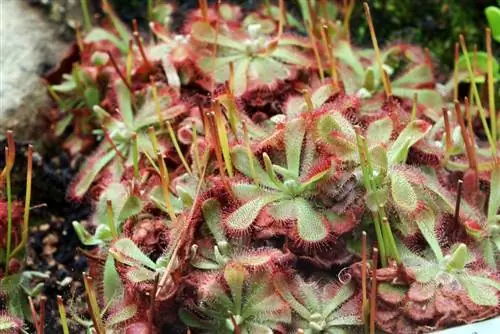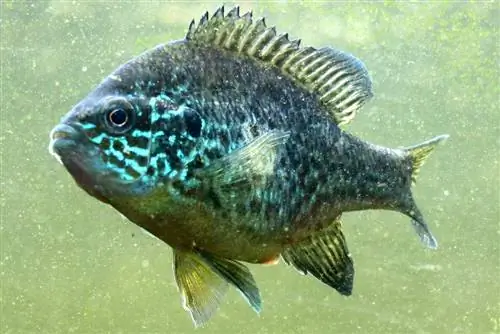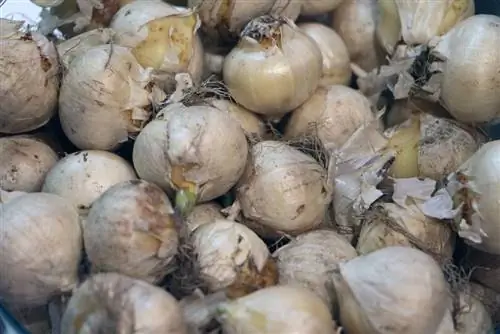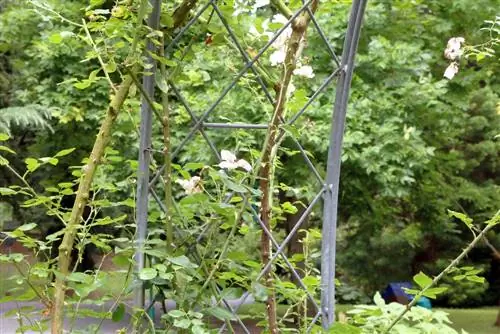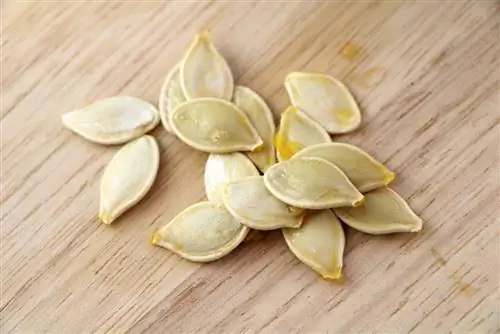- Author admin [email protected].
- Public 2023-12-17 03:39.
- Last modified 2025-01-24 12:45.
Those who love carnivorous plants nurture and care for them and give them everything they need. Lots of water and a few insects. A suitable pot for your roots and a place to stand where you feel comfortable. However, subtropical and tropical carnivores only really feel at home in a moist and warm place. Don't worry, you can easily recreate a tropical world in miniature in a terrarium.
Everything about repotting
Repotting a carnivore is very easy. She is given a new pot as planned about once a year. In most cases, the old substrate is then completely replaced with a new one. The most important thing is that you use a suitable pot and suitable soil. However, repotting is stressful for the plant, so the necessity should always be questioned before each repotting. Repotting should only be done if there is an advantage, otherwise it is better to wait another year.
Substrate for carnivores
If you buy ready-made carnivore soil from the store, you can't go wrong with it. Their composition is optimally tailored to the needs of carnivorous plants and has proven itself in practice. It is also easier and more practical to buy the soil ready-made. But you can also make your own mixture using peat and sand. It just shouldn't be nutrient-rich or contain any lime.
Suitable pot size
Carnivorous plants do not form as many roots as other plants. So you don't need a very large pot. The new plant container should therefore always be only slightly larger than the old plant container.
Suitable time for repotting
The optimal time to change pots is early spring. The winter dormancy of most carnivorous plants ends around February and March. If you get a larger pot and fresh soil at the beginning of the new growing season, these are ideal conditions for new growth. Sometimes there can be a good reason to repot the carnivores at another time.
- the plant is infested with vermin
- the earth has become too enriched with s alts and lime
Then don’t wait until next spring. Then repot the plant if necessary.
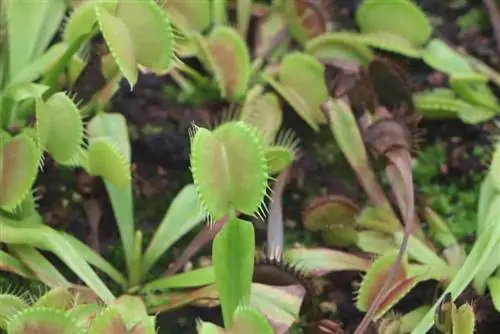
Carnivores only repot
If the current substrate is still in good condition, but the plant needs a different pot or is being planted in a different environment, you can repot or move it in the gentle way. This means that the root ball is transplanted along with the soil. The roots are not disturbed and do not have to re-root. They just get more scope for their further development.
- Put some soil in the new planter.
- Slightly squeeze the outside of the old plastic pot so that the soil comes away more easily.
- Carefully loosen the carnivore root ball from the old pot. Hold the root ball in your hand to prevent the soil from falling apart.
- Place the root ball with the old soil in the prepared new pot. The top edge of the root ball should line up with the top edge of the pot.
- Fill the space with new soil.
- Press the soil very lightly with your fingers.
- Water the repotted plant.
- Add soil if the soil has become compacted after watering and gaps have appeared.
Tip:
You can also carefully run a knife along the inside wall of the pot and loosen the bale from the pot, then it will be easier to remove afterwards.
Repot carnivores and replace substrate
With carnivorous plants there is often a need to completely replace the old soil. Especially in the following cases:
- the substrate is used up and starting to rot
- rotted substrate creates waterlogging
- there are nematodes in the substrate
- the earth is enriched with lime and s alts
When repotting and completely replacing the soil, proceed step by step.
- Stop watering a few days beforehand so that the soil dries out. This way the soil becomes looser and doesn't stick to the roots so much.
- Fill the new pot with fresh soil, leaving a hollow for the roots.
- Take the carnivores out of the pot.
- Carefully loosen the old soil from the roots.
- Rinse off any residue with water. If possible, with distilled water.
- Dead or damaged roots can be cut off using a sharp and clean knife.
- Place the plant in the hollow.
- Orient the roots as they grew before.
- Carefully add soil.
- Water the repotted plant and return it to its optimal location.
Tip:
If you discover small offshoots that have roots and leaves when repotting, you can use this opportunity to create offspring. Simply plant the offshoots in your own pot with carnivore soil.
Keeping in the terrarium

Most carnivores in this country are kept in pots and in normal rooms. The problem is often to provide the optimal conditions. In particular, the necessary high humidity is difficult to achieve. The development of subtropical and tropical species in particular is suffering. If you want to optimally care for your carnivorous plants, you should consider purchasing a terrarium. Spring, when the plants have finished their winter rest and are being repotted, is a good opportunity to put them in a terrarium straight away. Either with the pot or plant them in it.
Requirements for the terrarium
A glass terrarium is ideal for tropical and subtropical plant hunters. An aquarium can also be converted into a plant terrarium. A terrarium should offer at least the following:
- sufficient space for all carnivores
- good ventilation to prevent mold
- Components for increasing humidity
- Lighting lamps for sufficient light
Necessary elements for a terrarium
Setting up a terrarium initially costs money and time. But once it is finished, it can be used for a long time. The best thing, however, is that the subtropical and tropical plants will thrive much better in it.
- Glass terrarium or aquarium
- expanded clay
- water-permeable fleece
- special peat substrate for carnivorous plants
- optionally an indoor fountain, stream or waterfall
- Sprinkler system or ultrasonic atomizer for larger terrarium
- Spray bottle for smaller terrarium
- Lighting lamps
- Hygrometer for determining humidity
- Thermometer for measuring air temperature
- Sphagnum moss (holds moisture well)
- optional: natural materials for landscaping: stones, dry branches, etc.
The right location
Before you set up the terrarium, you should first find a suitable place where it can best stay all year round. It should be bright, but not too sunny. Especially in summer, the glass terrarium can become very hot due to strong sunlight. The temperature can quickly climb to values that are too high even for heat-loving plants.
Setting up the terrarium
The terrarium should be planned carefully so that the end result matches the ideas.
- First place the water fountain or similar if you chose to do so.
- Install the ultrasonic atomizer. (if planned)
- Fill the bottom of the terrarium evenly with expanded clay. The layer should be about 3 to 5 cm high.
- Place the water-permeable fleece on top. This prevents the soil and the expanded clay from mixing later.
- Water the carnivore soil so that it is moist. Then spread a 15 cm high layer onto the fleece.
- Add a layer of sphagnum moss over the soil.
- If the soil is moist and the water level in the terrarium is about 1 cm high, planting can begin.
- A beautiful landscape can be modeled using natural materials.
Tip:
The expanded clay should be washed thoroughly beforehand so that any s alts and foreign substances that may be present are removed.
Planting a terrarium
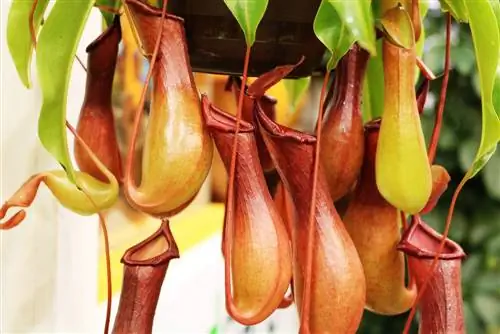
There are two ways to do the planting.
1. The carnivore remains in the pot and is placed in the terrarium with it.
2. The carnivore is removed from its pot and planted directly into the carnivore soil in the terrarium.
If the plant remains in the pot, it is buried in the ground so that it can no longer be seen. This looks more visually appealing. The advantage of keeping it in a pot is that each plant can be removed more easily if necessary. For example if she is sick. Some plants grow so quickly in the terrarium that they can overgrow each other. Corrections may then need to be made later. A few rules should be followed when planting the terrarium.
- Plant larger plants in the back, smaller plants in the front
- Plants that don't like waterlogging are planted higher
- leave enough space between the plants as they spread quickly
Which plants are allowed in?
The terrarium is primarily designed to meet the needs of tropical and subtropical species. However, it is also possible to keep winter-hardy species in it. It is important not to put plants with different requirements together in one terrarium. Since living conditions for both species cannot prevail at the same time, one species will inevitably lose out. Some subtropical and tropical species are also only partially suitable for a closed terrarium because they require more air circulation. Find out exactly what requirements your carnivores have before moving them into the terrarium. At the beginning, observe how the individual plants develop in the terrarium. This will give you peace of mind as to whether the move was right for you. If a plant weakens, it should perhaps be taken out again.
Wintering in the terrarium
All carnivorous plants in the terrarium can remain in it all year round. It is not necessary to take them out in winter and overwinter in another place. The only thing that needs to be ensured additionally is sufficient lighting in this cold season. A reduction in temperature may also be necessary for some species.
Care in the terrarium
The humidity and temperature should always be kept in mind so that both values are in the optimal range.
- Humidity approx. 80 to 90%
- Temperature at least 25 degrees Celsius
The expanded clay is a good watering indicator. Once it turns light in color, it's time to water. Spent soil should be replaced approximately every year. To prevent mold from forming in the terrarium, it must be well ventilated. Plant lamps, which are easiest to control with a timer, provide sufficient light. Sick plants must be removed from the terrarium so that they do not infect other plants.
Note:
Watering should always only be done with distilled water or rainwater because carnivorous plants tolerate hard water very poorly.

